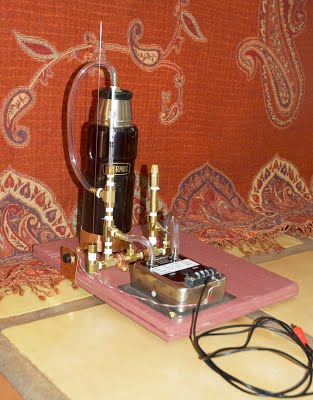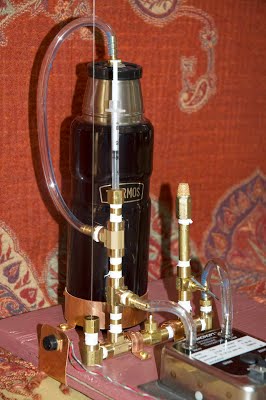What is it...

Sensitive vertical seismometers are effected by atmospheric air pressure changes and thus must be isolated from the open atmosphere with some sort of sealed container with very strong walls. Some of these containers are known to be built with 1/2" thick steel or aluminum welded boxes. To better understand the effect of air pressure changes it would be ideal to be able to monitor and record atmospheric air pressure change with time. The first thought was to utilize a La Crosse Technologies weather station unit that displays barometric readings. The unit outputs via a serial port mounds of data every minute. The only problem was it was impossible to understand the data and La Crosse Technologies was not at all helpful for my wishes. Another solution was a differential air pressure sensor. Stephen Hansen, the Bell Jar built such a unit as shown in the article Infrasound Monitoring with a Micrograph An infra-sonic atmospheric pressure sensor was built along the lines of the reference with some small changes. The unit is shown in Figure.
The differential air pressure transducer is an Ashcroft Model XLdp. The sensitivity is +/- 0.25" WC. Now 1 inch WC (water column) is equal to 2.49 milliBar , hence +/- 0.25" WC is equal to +/- .62 milliBar or +/- 620 uBar, a very sensitive unit. The output signal is a current loop of 4 to 20 millamp for the +/- 620uBar sensitivity. A 270 ohm resistor is inserted in the current loop and the voltage across the resistor is monitored. The sensors are readily available on  eBay in new condition for less than $100. See figure for a detailed view of the complete unit. The components are all 1/8" brass pipe fittings.
eBay in new condition for less than $100. See figure for a detailed view of the complete unit. The components are all 1/8" brass pipe fittings.
Concept of the infra-sonic atmospheric air pressure sensor is to measure the difference in air pressure between a reference volume on one side and the pressure now. The reference volume consists of a 450 mL Thermos bottle with a defined calibrated leak. The calibrated leak in this case is a 30 cm length of 0.008" ID SS tubing. There are 2 needle valves in the unit. One is between reference volume and the open atmosphere. This is normally closed but opened to equalize the pressure on both sides when zeroing the sytem. The second valve is just below the opening to the atmosphere and is closed when calibrating the unit. The hypodermic syringe is used to calibrate the unit for sensitivity and calibrated leak time-constant. The syringe capacity is 0.5mL. Sensitivity calibration consists of making a quick 0.25 mL change in the syringe and noting the change in voltage across the current loop resistor. Boyle's Law PV=K (constant temperature) is used to note the pressure change for reference volume change. The reference volume time-constant is measured by monitoring the voltage with time. The time-constant was defined by when the voltage reaches 63% of the final value from the peak. In this case the time-constant was measured to be about 220 seconds when using the 30 cm length of 0.008" ID tubing. The unit is very temperature sensitive , so a very stable thermal environment is required.